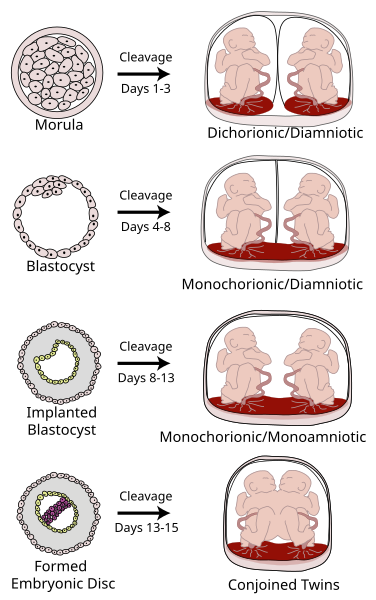IB Syllabus focus:
'- Principles of twin studies
- Findings related to heritability
- Strengths and limitations'
Twin studies stand as a cornerstone in behavioural genetics, illuminating the intricate interplay between genetic makeup and environmental factors. They've become an invaluable tool in dissecting the nature versus nurture debate, aiding researchers in discerning the relative contributions of genes and the environment to various behavioural traits and disorders. A deeper understanding of these foundational elements can be gained by exploring the basics of genetics.
Principles of Twin Studies
Types of Twins
Monozygotic (MZ) Twins: Often known as identical twins, MZ twins originate from a single fertilised egg that later splits into two embryos. This results in both siblings sharing 100% of their genetic material. These twins offer a unique vantage point to understand genetic influences as they are genetically identical.
Dizygotic (DZ) Twins: These are the fraternal twins, born when two distinct eggs are fertilised by two separate sperm cells. Sharing approximately 50% of their genetic material, DZ twins have genetic similarities akin to regular siblings.

Labeled schematic contrasting monozygotic and dizygotic twin development, including monochorionic/dichorionic placentation. While chorionicity exceeds the IB syllabus scope, it clarifies how identical versus fraternal twins arise. Source.
Core Concepts
Concordance Rate: A crucial term in twin studies, the concordance rate indicates the percentage of cases where both twins (either MZ or DZ) exhibit a specific trait or disorder. A higher concordance rate in MZ twins compared to DZ twins for a particular trait suggests a more pronounced genetic influence.
Shared vs Non-shared Environment: While twins might share a familial environment, individual experiences can differentiate one twin from the other. These distinct experiences, termed as non-shared environmental factors, can crucially influence behaviours and traits. The role of these environmental factors is further examined in the context of nature vs nurture.
Findings Related to Heritability
Defining Heritability
Heritability Coefficient: This is a metric that quantifies the genetic contribution to the variance in a trait within a population. It doesn’t represent the extent to which genes determine an individual's trait, but instead, the variability of that trait in a particular population due to genetic factors.

Standard ACE twin model showing how phenotypic variance is partitioned into additive genetic (A), shared environmental (C), and non-shared environmental (E) components. The diagram emphasises that heritability is about population variance, not destiny for individuals. (Numeric coefficients are illustrative and exceed the syllabus depth.) Source.
Twin Studies' Insights
Intelligence: Twin research reveals that intelligence, often measured using IQ scores, has considerable genetic underpinnings. While estimates suggest a heritability range from 0.5 to 0.8, it’s pivotal to recognise the significant influence of environmental factors, especially those in early developmental stages. Insights into how the brain adapts and evolves in response to these factors can be further explored through studies on neuroplasticity.
Mental Health Disorders: Certain disorders, such as schizophrenia or bipolar disorder, show higher concordance rates in MZ twins than in DZ twins. However, these findings don't undermine the profound environmental triggers, indicating that both genetics and environment shape vulnerability and manifestation. The complex interplay of hormones like oxytocin in social behaviour and mental health offers additional layers of understanding in this domain.
Personality Traits: The intricacies of personality—traits like agreeableness, conscientiousness, or openness to experience—have also been under the twin research scanner. While there's a genetic component, individual experiences, upbringing, and cultural contexts significantly mould these traits. The influence of broader sociocultural factors on these aspects of personality underscores the dynamic interplay between individual predispositions and external influences.
Strengths and Limitations
Strengths
1. Genetic Control: Twins, especially MZ pairs, offer researchers an almost unparalleled control over genetic variables. This makes it easier to hone in on the effects of environmental differences.
2. Rich Data Source: Cases where twins have been separated at birth and then reared in contrasting environments are natural experiments in their own right. They offer deep insights, revealing how different upbringings can lead to variances in traits and behaviours.
3. Wide Range: Twin studies aren’t confined to just behavioural traits. They encompass a spectrum, from understanding the genetic basis of diseases to cognitive abilities, painting a comprehensive picture of human nature and nurture.
Limitations
1. Equal Environment Assumption: One major critique is the assumption that MZ and DZ twins experience equally similar environments. This is often not the case. MZ twins might face more identical treatments or share closer bonds, which can influence behavioural outcomes.
2. Generalisation Concerns: Twins, particularly those separated at birth, might not represent the broader population accurately. The uniqueness of their situation can introduce biases, making it challenging to extrapolate findings.
3. Complexity of Gene-Environment Interaction: Human behaviour and traits are a product of intricate gene-environment interactions. Twin studies, while powerful, can only offer approximations. The real-world interplay of genes and environment often transcends the dualistic nature versus nurture framework.
Delving Deeper: Epigenetics
While not a primary focus of traditional twin studies, the burgeoning field of epigenetics adds another layer to our understanding. Epigenetic markers, which influence gene expression without altering the underlying DNA sequence, can be influenced by environmental factors. Interestingly, MZ twins, while genetically identical, can showcase differences in epigenetic markers. This further underscores the symbiotic relationship between genes and the environment, highlighting that they aren't isolated actors but intertwined forces shaping human behaviour.

Fluorescent overlay of chromosome images from monozygotic twins, where one twin’s epigenetic tags are red and the other’s are green; overlapping tags appear yellow. The comparison (e.g., 3-year-old vs. 50-year-old twins) illustrates how environmental exposure and age shape epigenetic patterns over time. Source.
In wrapping up this exploration of twin studies, it's evident that they serve as a linchpin in behavioural genetics. While they've illuminated many aspects of the genetic and environmental origins of human behaviour, they also underline the vast complexities inherent in this field. For IB Psychology students, twin studies stand as a testament to the multi-faceted nature of human beings, reminding us that simple answers are rarely sufficient in the realm of psychology.
FAQ
The equal environment assumption posits that MZ and DZ twins share equivalent environmental influences. Critics argue this isn't always true. MZ twins may be treated more similarly, dressed alike, or even enrolled in the same activities, potentially intensifying their behavioural similarities. Moreover, the closer emotional bond MZ twins often share might affect their behaviour. If these environmental factors aren't accounted for, it could lead to overestimation of genetic influences on certain behaviours.
Twin studies traditionally focus on the influence of genes on a single trait. However, modern approaches, aided by advances in genetics, have started to explore polygenic traits – those influenced by multiple genes. Though it's complex, researchers are beginning to analyse how sets of genes together influence behaviours. This polygenic perspective represents a significant evolution in behavioural genetics, allowing for a deeper understanding of the intricate genetic factors underlying human behaviour.
Such cases are termed "discordant twin studies" and provide a unique opportunity to examine the impact of different environments on individuals with similar or identical genetic makeups. If twins raised apart exhibit similar behaviours, this strengthens the argument for genetic influence. However, if they exhibit differences, it highlights the importance of environmental factors. These studies, though rare, offer a compelling glimpse into the complex interplay of genes and environment.
Yes, while many behavioural traits have shown some degree of heritability, not all traits are influenced by genetics. It's crucial to understand that heritability scores only indicate the proportion of variability in a trait within a population due to genetic factors, not the absolute degree to which genes determine a trait. For some behaviours, twin studies may indicate low or negligible heritability scores, suggesting that the environment plays a more dominant role in those specific cases.
Pairing twin studies with adoption studies provides a more comprehensive insight into the nature vs nurture debate. Twin studies isolate genetic influences, whereas adoption studies contrast biological relatives and adoptive families, focusing on environmental effects. When a trait appears in both adopted children and their biological parents, there's a suggestion of genetic influence. On the other hand, if the trait aligns more with the adoptive family, environment plays a key role. Thus, combining these methodologies allows for a finer dissection of genetic and environmental contributions to behaviour.
Practice Questions
Monozygotic (MZ) twins, commonly known as identical twins, originate from a single fertilised egg that later divides, resulting in both twins sharing 100% of their genetic material. In contrast, dizygotic (DZ) twins, or fraternal twins, are born from two distinct eggs fertilised by two separate sperm cells, sharing roughly 50% of their genes, similar to regular siblings. In twin studies, these distinctions are pivotal. Higher concordance rates in MZ twins than in DZ twins for a particular trait indicate a strong genetic influence, given the genetic similarities of MZ twins. This differential allows researchers to disentangle genetic and environmental influences on behaviour.
A major strength of twin studies is the genetic control they offer. Especially with MZ twins, researchers have an unparalleled control over genetic variables, allowing for clearer insights into the effects of environmental differences on behavioural traits. However, a significant limitation is the equal environment assumption. Twin studies often presume that MZ and DZ twins experience similar environments. This isn't always accurate, as MZ twins might share closer bonds or face more identical treatments than DZ twins. Such discrepancies can influence behavioural outcomes and skew findings related to genetic and environmental contributions.

